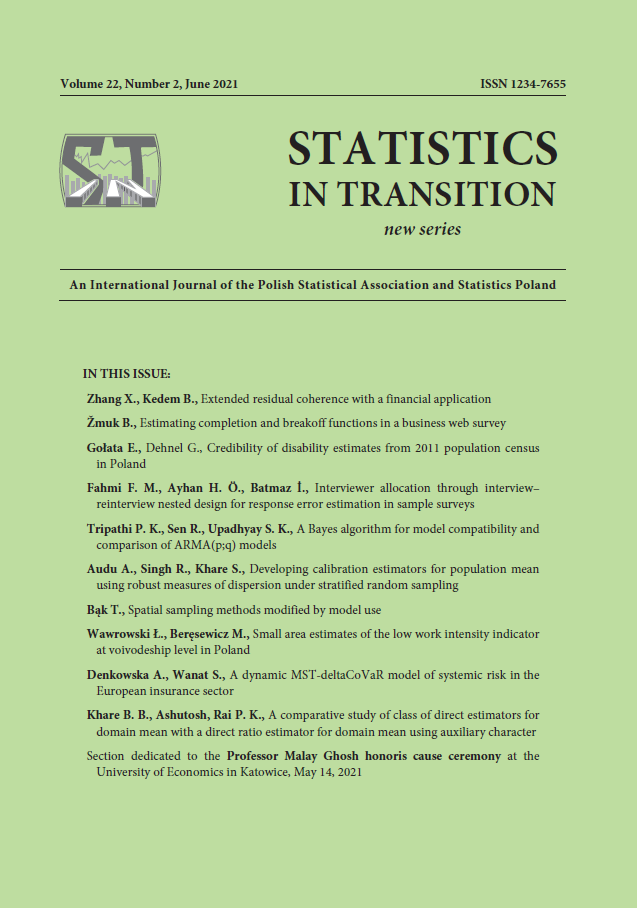ARTICLE
ABSTRACT
Estimation techniques for a domain parameter play a very significant role in the theory of sample surveys. In the recent years many advanced methodologies have been developed for domain estimation. In particular, direct and synthetic estimators are applied for the estimation of domain mean in the government and private sectors under certain assumptions as to the size of the samples relating to particular domains. The findings demonstrate that the direct estimator fails to perform more efficiently as compared to the synthetic estimator when reliable units are not directly accessible in the studied domains. Moreover, due to the fact that small units belong to the sample of the studied domain, the direct estimator produces an unacceptably large standard error. In contrast, if a sufficient number of units are available in the studied domain, the direct estimator produces effective results. This paper presents the theoretical aspects of the proposed class of direct estimators for domain mean with the use of a single auxiliary character, compared with an existing direct ratio estimator for domain mean (given in section 3.2). In addition, an empirical study has been provided to support the validity of the proposed estimators. The findings prove that the proposed estimators outperform the direct ratio estimator for domain mean using a single auxiliary character in the case of two studied populations and their analysed domains considered from Sarndal et al. (1992).
KEYWORDS
domain, auxiliary character, direct ratio estimator, class of estimators, mean square error (MSE)
REFERENCES
Gonzalez, M.E., (1973). Use and Evaluation of Synthetic Estimators, Proceedings of the Social Statistics, American Statistical Association, pp. 33–36.
Khare, B. B., Pandey, S. K., (2000). A Class of Estimators for Ratio of Two Population Means using Auxiliary Character in the Presence of Non-Response. Journal of Scientific Research, BHU, 50, pp. 115–125.
Khare, B. B., Sinha. R. R., (2009). On Class of Estimators for Population Mean using Multi-Auxiliary Characters in the Presence of Non-Response, Statistics in Transition-New Series, 10, 1, pp. 3–14.
Khare. B. B., Ashutosh., (2017). Synthetic Estimator for Domain Mean Using Auxiliary Character, International Journal of Statistics and Economics, 18, 4, pp. 32–44.
Khare, B. B., Ashutosh and Khare. S., (2018). Comparative Study of Synthetic Estimators with Ratio Estimator for Domain Mean in Survey Sampling using Auxiliary Character. International Journal of Applied Mathematics and Statistics, 57, 3, pp. 152–161.
Rai, P. K., Pandey, K. K., (2013). Synthetic Estimators using Auxiliary Information in Small Domains. Statistics in Transition-New Series, 14, 1, 31–44.
Rao. J. N. K. (2003). Small Area Estimation, Wiley Inter-Science, John Wiley and Sons, New Jersey.
Reddy, V. N., (1978). A Study on the Use of the Prior Knowledge on Certain Population Parameters in Equation. Sankhya. 40, pp. 29–37.
Sarndal, C. E. Swensson, B. and Wretman, J. H. (1992). Model Assisted Survey Sampling, Springer-Verlog, New York.
Srivastava. S. K. (1971). A Generalized Estimators for the Mean of a Finite Population using Multi-Auxiliary Information, International Journal of American Statistical Association. 66, pp. 404–407.
Srivastava. S. K., Jhajj. H. J., (1981). A class of Estimators of the Population Mean in Survey Sampling using Auxiliary Information. Biometrika. 68, 1, pp. 341–343.
Srivastava, S. K., Jhajj, H. J., (1983). A Class of Estimators of the Population Mean using Multi Auxiliary Information. Calcutta Statistical Association Bulletin. 15, pp. 127–134.
Tikkiwal. G. C., Ghiya. A., (2000). A Generalized Class of Synthetic Estimators with Application to Crop Acreage Estimation for Small Domains. Biometrical Journal. 42, 7, pp. 865–876.
